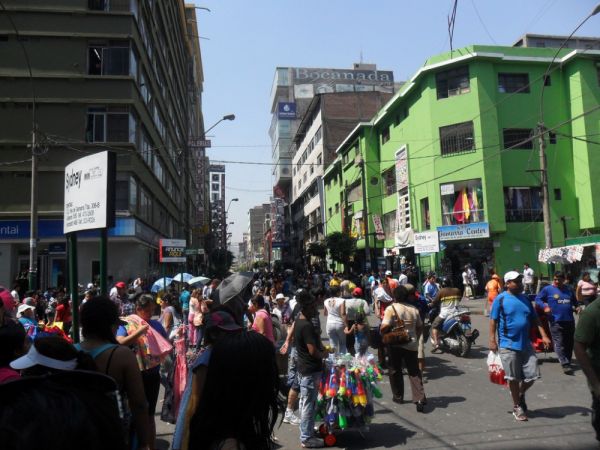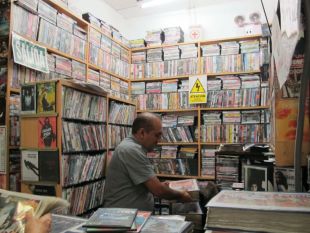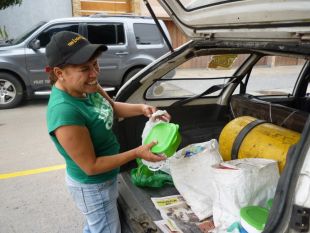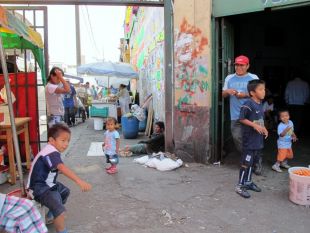Though Modernizing Fast, Informality Remains the Beating Heart of My City

The Gamarra section of Lima, one of the world’s largest textile districts.
Its never been hard to find informality in Lima. Stand on any street corner, and you’re bound to see an unlicensed taxi driver looking for his next customer, a pirated-book vendor hawking the latest bestsellers, an informal recycler rummaging through the trash in search of plastic bottles. The number of informal transactions taking place in Lima at any given second, pushing the economy forward in ways big and small, are virtually incalculable.
Looking at some figures, Lima’s ubiquitous informal economy is no surprise. Statistics vary, but most seem to indicate that informal activity accounts for 60 to 70 percent of the country’s economy. The number is so high that in a 2007 report the World Bank estimated that Peru’s informal workers comprised one of the world’s largest “shadow economies.”

An informal DVD salesman in Lima.
Over the course of these past nine months, the Informal City Dialogues has taken me on a beautifully strange trip through Lima, and has made me realize that the word “shadow” does a disservice to the interplay between its formal and informal worlds. Beyond the staggering statistics, Lima’s informal economy is made up of real people, with real human stories, stories of what it’s like to live in this city.
Stories like those of Mr. German, who pedals his bicycle cart through downtown Lima before the sun rises to give himself just enough time to start squeezing fresh oranges during the morning rush hour. Stories like that of Freddy, the Gamarra entrepreneur who started sewing tank-tops in the mid ’90s, and turned his $11 investment into seven profitable — and formal — textile workshops.
But for every story I documented during this project there were countless more that went untold. Although I was prepared for some rejection, I was always surprised by how many people refused to talk to me. Some of them declined politely, others less so. The reluctancy many informal workers felt to speak about their lives is a testament to the persecution they feel. Their wariness about sharing their experiences points to the stigma they associate with their informal employment. Edilberto Delgado, for instance, a lifelong informal recycler, said he never told his family of his job for fear of being shamed. In many parts of the world his efforts to recycle discarded materials would be celebrated.

A woman who sells prepackaged meals to construction workers.
Looking at Lima’s massive public transport problems for a Forefront article was also a chance to appreciate just how crucial informal transportation has been in connecting the city at a time of severe growing pains. The history of the city’s transportation woes seems to perfectly exemplify the dynamic between the formal and informal worlds.
But despite how much the city relies on the informal realm, at times Lima seems to turn its back on the economic sectors that have enabled its growth over the past decade, often casting them aside. One morning, standing at the site of a proposed fence that would separate an informal settlement from an upscale neighborhood, I felt frustration at the divisions in my city. Perhaps us Limeños are able to turn a blind eye toward informality only until it is too close for comfort.
As I saw at Lima’s La Parada market, there is no doubt that at times informality can stand in the way of the city’s modernization and security. There is no doubt that the current informal situation is unsustainable. But as we move forward, perhaps we should also take a moment to thank the informal economy for adapting to change, and for including those who have been excluded elsewhere.

A family at La Parada market.
The driving force behind Lima’s informality is vast and varied. For some of the people I spoke to, informality was just a first step when starting a businesses they hoped would someday be formalized. But for others, informality was a byproduct of feeling excluded from the formal economy because of complicated bureaucracy or language barriers. Despite these differences, the people I spoke to all had one thing in common: Each of them are looking for a way to make a living.
As we reach the end of the Informal City Dialogues, that last word, dialogues, is the one that most stands out. I hope the stories I’ve helped to tell will be of use in the conversation that Lima continues to have.
Photos by Manuel Vigo









